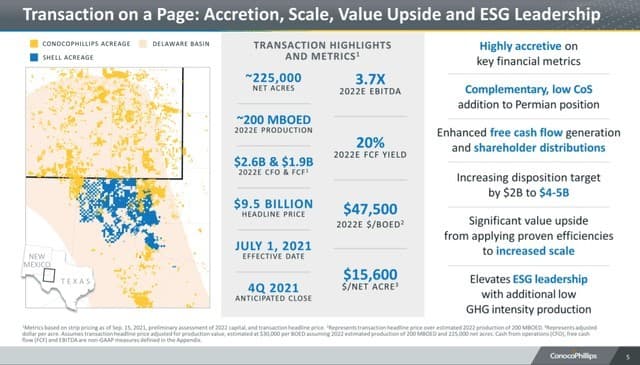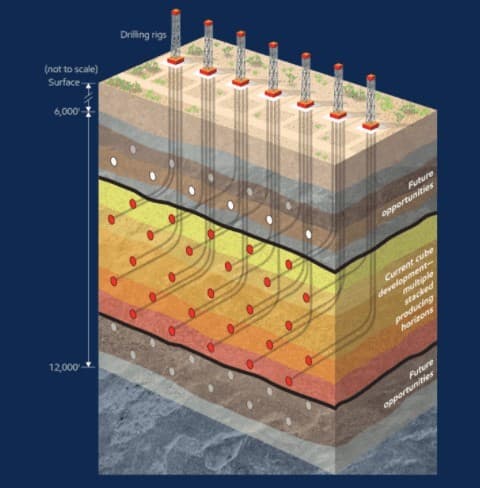by David Messler
- European oil majors are working hard to cut their emissions by shedding assets as they attempt to become energy majors
- One of the highest-profile cases of this transition so far was the sale of Shell’s Delaware acreage to ConocoPhillips (NYSE:COP)
- The market has responded by rewarded COP with a 25% increase so far this week, but the real value is yet to be realized.
The Euro majors have been shrinking their legacy high carbon portfolios to transition their product mix to meet the lower carbon climate goals of the Paris Accord. This is driven by a combination of internal conviction at the executive level, investor revulsion at the "harm" hydrocarbons are doing to the planet, and fear of climate litigation hitting them.
We have seen this trend accelerate in recent years with Royal Dutch Shell (NYSE:RDSa) (LON:RDSa) making the most recent splash last week by shedding its previously core Delaware acreage in the Permian Basin. BP, (NYSE:BP), TotalEnergies (NYSE:TTE), and Equinor (NYSE:EQNR), have made similar moves to divest carbon unfriendly assets, or have committed to doing so.
The soundness of this strategy remains to be seen from a business perspective, as these companies are focusing their efforts on, and allocating capital toward, green energy businesses that have no long-term track records. In an article last month I noted that there were cracks in the green energy story that a transition will be smooth and easy.
In this article, I will discuss some aspects of what this acquisition may mean to ConocoPhillips and conclude with an estimate of the impact on its stock price.
The deal
This week ConocoPhillips and Shell made a deal to transfer title to Shell's Permian acreage for $9.5 bn in cash. Using simple math, the 225K acre Delaware footprint works out to $42K and change per acre. A little steep these days, but COP defended it on the basis of existing production. Easily justified, but we will stick to simple math.

source: ConocoPhillips
The deal has been generally lauded by the market and COP stock is up 25% in a week, outpacing many others. It should be noted this was a pretty good week for the oil market where the news generally focused on declines in supply in the U.S. and Europe, and the associated high prices that scarcity inflicts on commodity prices.
We think this will add value to ConocoPhillips over and above the linear addition of acreage and present production to its previous portfolio. The Shell acreage makes its former Delaware position that much more valuable as we will discuss.
Things that the market doesn't generally take into account
There's no question that Shell sold to satisfy climate-related imperatives. That is of course their call, however misguided one might think it is. The question we are going to ask and then answer in this article is what the "behind the scenes” calculus might have been that enabled COP to shell out $9.5 bn in cash for this Delaware acreage.
Reservoir management
Oil companies can now, using seismic data and advanced processing software, realistically construct a "picture" of the subterranean strata from which they plan the most efficient draining of the reservoir(s). In the acreage above, imagine that one of the common Permian targets, the Wolfcamp, is running north to south (or vice versa depending on your perspective).
If you are a Shell engineer planning a well you have to plan the overall trajectory with the COP acreage above yours in mind because you can't cross the line. Obviously, merging the properties enables the COP asset development team to plan its well paths without that particular constraint. Among the advantages this confers are:
- Avoiding faults in the reservoir that may cause drilling delays/problems. Faults are associated with geosteering difficulties-keeping the bottom-hole assembly headed toward the target, loss-circulation, and hole-collapse. Any one of which can be catastrophic and result in flat time or redrilling.
- Minimizing tortuosity. Curves and bends in a well path increase the mechanical risk exponentially. Blocky, connected acreage promotes minimization of these "doglegs."
- Optimal well path targeting for maximum drainage of the reservoir. Visualize the reservoir in 3D and you will see the impact this might have on ultimate recovery from the zone.
Permeability and porosity
If you have read more than a few of my articles you have run across these terms. Discussions that include permeability and porosity can get really wonky regarding these factors of well production. For this article, we will just highlight them with a brief description for each. Permeability is the flow characteristic that describes the rock's ability to flow fluids toward the well bore. More perm is always better than less perm. Porosity is a measure of the void space in the rock that enables hydrocarbons to accumulate. More porosity is always better than less porosity.
The relevance to the value that the Shell acreage brought to COP is the ability to plan the well path in the maximum permeability and porosity areas of the reservoir, again using the very realistic pictures of the subterranean environment that are possible today. This will enhance ultimate recovery in addition to any stimulation treatment applied.
Casing exits
Wells start out vertically most of the time anyway. When they reach a certain depth there is a kick-off point to where they begin the horizontal leg. This is referred to as the casing exit, from which point the rest of the well is referred to as the "open-hole." Ideally, the casing exit occurs in the sweet spot of the reservoir and puts the best part of the reservoir closest to the vertical section.
This reduces mechanical risk and helps to ensure the best part of the reservoir will remain available regardless of how the well is produced. Wells are opened selectively to encourage maximum drainage from the farthest point and to minimize water intrusion that can shut off hydrocarbons.
Cube style development
I doubt this term is foreign to you as over the last five years it's become a commonplace reservoir drainage strategy. We'll cover it here briefly for the sake of completeness. The cube enables the design of well paths to minimize well-to-well impacts-frac hits, and harmonics from one well to another chiefly.

source: Exxon Mobile
Cubes also provide for multi-lateral opportunities as shown in the graphic above.
Lateral length
Just a brief word here as this concept is pretty well understood by now. A few years back Permian laterals were 5-6,000' in length. Today they run 9, 10, 11, 12,000 feet commonly and in some cases go to 15,000 feet. It should be easily evident to you as to how the Shell acreage can positively impact this aspect of reservoir development.
Scale
Another feature of this transaction, and one touched on in the slide above. What does it mean? It can have a number of impacts from contracting with suppliers for pumping, sand, water services, etc., and supply base centralization. Oil and gas volumes as well. Carriers are looking to fill up their lines, so having additional production and the promise of more as new wells are developed can gain COP an advantage in negotiations.
I'll stop here. At this stage of maturity, the trend is asset consolidation that lends itself to an "oil manufacturing" state, where processes are streamlined, and inputs standardized. Sort of like car manufacturing when you think about it.
Tier I acreage
Finally, there is the matter of rock quality. All rock is not created equal in terms of Drillability, reservoir connectedness and thickness, oil quality, pressure, and the other characteristics that establish the tier of a reservoir.
For example, take the Wolfcamp-A in the Permian. It sits above the Wolfcamp-B, C, and D. These are generally classed as lower tier than the A, as they require additional drilling to tap. They may also lack some of the attributes of the A, as well as having lower porosity and permeability due to diagenesis. Foot for foot of interval, these horizons will typically yield less than the Wolfcamp-A, extending payouts and perhaps making them uneconomic to drill.
In buying the Shell acreage, COP picked up additional Tier I acreage. This will keep their costs down relative to peers and enable them to continue operations in times of lower prices. In the period we just exited where low prices dominated, mostly only Tier I acreage was drilled.
Your takeaway
As you can see, there is much more to evaluating this deal than just the price paid for the acreage. We think the big, blocky footprint of COP’s acreage enhanced by the assets obtained from Shell will be more than accretive as soon as the deal is closed. Further, we believe the share price of COP will respond favorably.
At the close of business last week, COP was trading at an EV/EBITDA of 5.9X using Q-2, 2021 numbers. This is ridiculously cheap and should propel the stock higher when the company reports Nov. 2. The 200K BOEPD of production that came with Shell’s acreage probably adds $3.0 bn of annual EBITDA driving the multiple down still further toward 5X. A figure that won’t be reflected in earnings until the deal closes later this quarter.
A 7X multiple which we think the stock is powering toward at present, would put the price of the stock in the $95-$100 range. Given its reserves, daily production, and the stock prices of competitors like Pioneer Natural Resources, (NYSE:PXD) $174-ish, and EOG Resources $84-ish, this range could be easily exceeded in the supportive market extant at present.
Related: The Global Supply Chain Crisis Could Last Until 2023
Related: World's Largest Commodity Traders Burned By Massive Wrong Bets On Natural Gas
